Start with short 5-10 minute light therapy sessions and gradually increase to 15-20 minutes as your body adjusts. Place the device directly on your skin at the pain source, ensuring proper contact and following the manufacturer's placement guidelines. Maintain daily treatments, especially in the first few weeks, spacing multiple sessions at least six hours apart. Combine therapy with gentle stretches and movement to enhance benefits. Choose the right wavelength – 850nm for deep tissue or 660nm for surface healing. Clean the treatment area thoroughly and track your progress using a pain scale. These foundational tips will set you up for ideal joint pain relief results.
Optimal Treatment Time And Duration
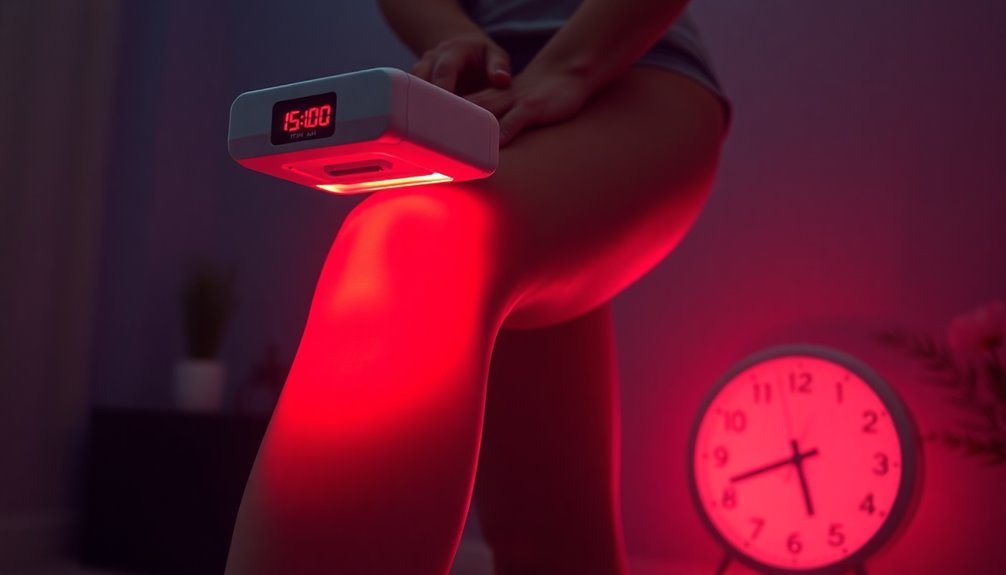
Successful light therapy treatment depends on finding the right balance of time and frequency. When you're just starting out, begin with shorter 5-10 minute sessions to let your body adjust to the treatment.
As you become more comfortable, you can gradually increase session length to 15-20 minutes, but don't exceed two sessions per day. It's important to space any multiple daily treatments at least six hours apart.
For joint pain relief, you'll want to maintain consistent daily treatments, especially during the first few weeks. Most devices come with preset therapy times, making it easier to stick to recommended durations.
While treating your joints, make certain the light covers the affected area thoroughly for maximum effectiveness. You'll typically need 3-4 weeks of regular use before seeing significant improvements.
Track your progress with a pain journal to understand how your body responds to the treatment. If you experience any discomfort, like mild headaches, you're likely overexposing yourself – scale back your session time.
For conditions like knee osteoarthritis, aim for at least 10 minutes per treatment. Remember, it's better to start conservatively and adjust based on your body's response rather than risking overexposure through lengthy sessions.
Device Placement For Maximum Relief
Positioning your light therapy device correctly makes the difference between mediocre and maximum relief. To achieve the best results, make certain of direct skin contact and place the device precisely at the source of your pain.
When treating joints or muscles, adjust the angle to follow your body's natural contours while maintaining consistent contact with the affected area.
For larger treatment areas or multiple joints, you'll want to think about using multiple modules to provide thorough coverage. The device's ergonomic design allows for comfortable positioning on any body part. Always secure the device properly to prevent shifting during your session, especially if you're moving or staying active during treatment.
Remember to target specific pain points and inflammatory sites directly, as this enhances the therapy's effectiveness.
To avoid common placement mistakes, follow your manufacturer's instructions carefully and never point the device at your eyes. Keep an eye on your skin's reaction and the device's temperature during use.
You'll get the best results by maintaining a consistent treatment schedule and adapting the placement to your specific needs. If you're unsure about proper positioning, don't hesitate to seek professional guidance for personalized placement recommendations that match your condition.
Consistent Daily Treatment Schedule
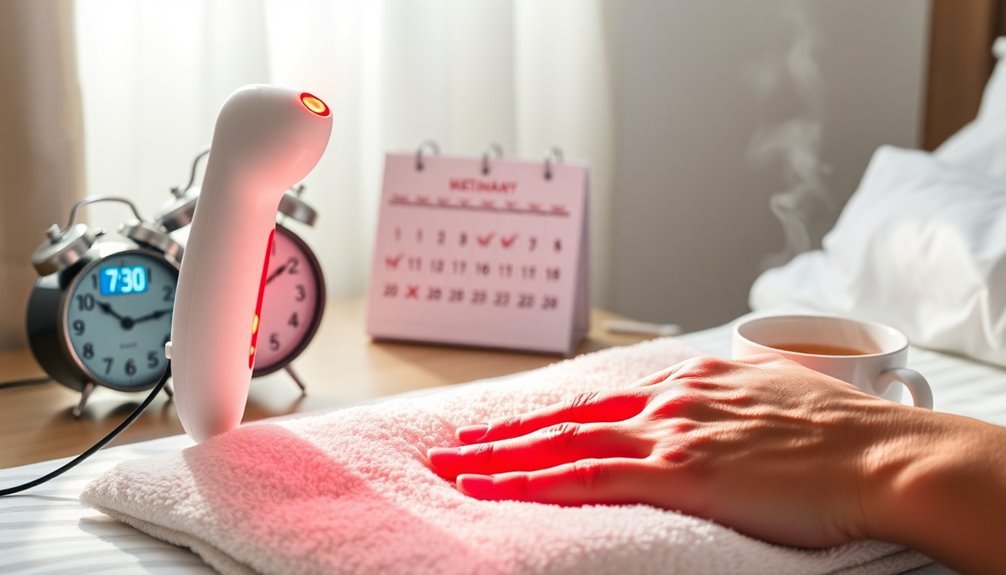
While achieving lasting joint pain relief requires dedication, establishing a consistent daily treatment schedule will maximize your results. For the best benefits, you'll want to use red light therapy daily, particularly when first starting treatment.
Begin with 10-minute sessions and gradually work your way up to 15-20 minutes as your body adjusts to the therapy. ATP production increases during each session, helping repair damaged joint tissue.
If you're dealing with severe joint pain, you can safely use the device twice daily, but make sure to monitor your body's response. You'll typically see the best results with daily 15-minute sessions, which can effectively reduce arthritis symptoms and provide sustained relief.
Remember that short, regular sessions are more beneficial than sporadic longer ones.
Once your symptoms improve, you can reduce your treatment frequency to 2-3 times weekly for maintenance. Keep in mind that your individual needs may vary based on your age, health condition, and light sensitivity. You'll need to customize your schedule accordingly, paying attention to how your body responds.
Unlike temporary solutions such as painkillers, consistent red light therapy can offer long-term relief when you maintain a regular treatment schedule.
Combining Movement With Light Sessions
You'll get the most benefit from your light therapy by incorporating gentle stretches during your treatment sessions, especially when targeting stiff joints.
Follow up your light therapy with simple movement exercises like walking or light yoga to keep joints mobile and maximize the therapy's effects. Regular movement helps maintain the enhanced blood flow that red light therapy creates in your tissues.
Start your day with a morning routine that combines targeted light therapy and mobility work to set a foundation for better joint function throughout the day.
Stretch During Light Treatment
Combining stretching exercises with your light therapy sessions can substantially amplify the healing benefits for joint pain. When you stretch during treatment, you'll enhance flexibility, reduce muscle tension, and improve blood circulation to the affected areas. This combination promotes faster tissue repair and increases ATP production, leading to more effective pain relief. A clinical study found that three sessions per week of combined light therapy and stretching produced significant improvements in pain reduction.
You'll want to focus on both static and dynamic stretches during your light therapy. Hold gentle static stretches to target specific areas of tension, and incorporate smooth, rhythmic movements to boost circulation and lymphatic drainage.
Don't overdo it – start with gentle movements and gradually increase intensity based on your comfort level.
Before starting this combined approach, consult your healthcare provider to verify it's appropriate for your condition. You'll need to maintain proper form and avoid overstretching, which can cause injury. Pay attention to how your body responds and adjust accordingly.
Research shows this integrated approach can provide both immediate and long-term benefits for joint pain management. If you're using other treatments, make sure to discuss potential interactions with your healthcare provider to create a safe, thorough treatment plan.
Post-Session Movement Exercises
Along with light therapy sessions, incorporating post-treatment movement exercises can maximize your pain relief and joint mobility. You'll want to focus on low-impact activities that won't stress your joints while still promoting strength and flexibility. Consider activities like rebounding, walking, or swimming after your light therapy sessions.
To get the most benefit, start with gentle movements and gradually increase intensity as your body adapts. Following movement exercises with red and near-infrared light can help accelerate muscle regeneration and reduce inflammation. Aim for 2-3 sessions per week, staying consistent with your routine rather than exercising sporadically.
Remember to stay well-hydrated, as proper hydration enhances the effectiveness of both your light therapy and exercise routine.
When exercising, target the specific joints that are experiencing pain while incorporating range of motion and strengthening exercises. If you're new to exercise or have existing health conditions, consult your healthcare provider before starting.
Always listen to your body and modify movements based on your limitations. If you experience unusual pain or discomfort, stop immediately.
Morning Mobility Light Routine
A powerful morning routine that pairs light therapy with gentle movements can substantially enhance your joint pain relief efforts. You'll want to dedicate 15-20 minutes each morning to this combination therapy, as it directly targets affected tissues while stimulating natural healing processes within your joints. Using specific wavelengths of red and near-infrared light helps trigger the release of natural painkillers called endorphins.
| Time of Day | Activity | Benefits |
|---|---|---|
| Early Morning | Light Therapy | Enhanced cellular repair, reduced inflammation |
| Mid-Morning | Gentle Exercise | Improved joint mobility, increased blood flow |
| Late Morning | Combined Therapy | Maximized pain relief, better range of motion |
For ideal results, you'll need to maintain consistency with your routine. Start by positioning your Move+ device on the affected joint while performing gentle stretches or movements. You can expect to notice improvements after about a week of regular use, though individual results may vary. As your symptoms improve, you can gradually reduce the frequency of sessions while maintaining the benefits. Remember to follow proper device instructions and consider combining your light therapy with other treatment modalities like ultrasound for enhanced results. This home-based approach eliminates the need for frequent clinical visits while providing effective pain management.
Choosing The Right Wavelength
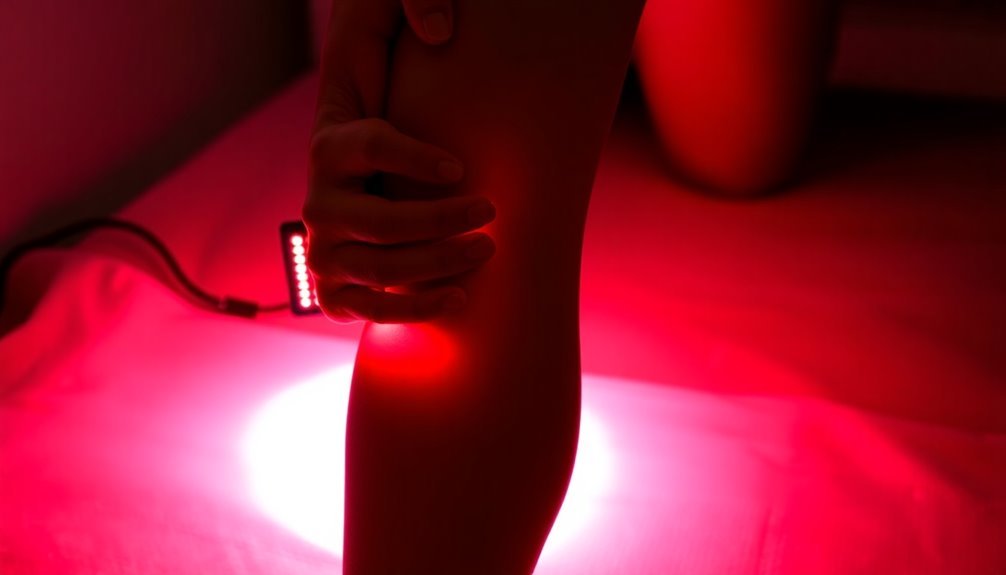
When selecting wavelengths for joint pain relief, you'll need to match the light's penetration depth with your specific condition. For deep joint pain, 850 nm near-infrared light penetrates effectively into deeper tissues, while 660 nm red light works best for surface-level issues. Cellular metabolism and ATP production increases during treatment to promote natural healing processes.
You'll get thorough results by combining both wavelengths, as they work together to address inflammation and promote healing at different depths.
For effective joint pain treatment, consider these key wavelength factors:
- Near-infrared light (850 nm) penetrates deeper tissues and targets inflammation in joints
- Red light (660 nm) stimulates surface healing and complements deeper treatments
- Combined wavelength therapy provides all-encompassing coverage for both superficial and deep tissues
- Treatment sessions should last 10-20 minutes with the device positioned 6-12 inches from the affected area
- Clinical studies show over 50% pain reduction when using appropriate wavelengths consistently
When choosing a light therapy device, make sure it includes both red and near-infrared wavelengths for maximum effectiveness. Look for devices backed by peer-reviewed research and clear usage instructions.
Regular, consistent application is essential for achieving the best results in managing joint pain and inflammation.
Preparation Before Light Therapy
Before starting light therapy for joint pain, proper preparation can substantially enhance your treatment's effectiveness. You'll need to understand your specific joint condition through proper diagnosis and establish clear treatment goals. Work with your healthcare provider to assess your symptoms and create a baseline for tracking progress.
Prepare your body by gently warming up the affected area and making certain you're well-hydrated. Don't forget to rest adequately before treatment, and maintain a nutrient-rich diet to support your joint health. Clean the treatment area thoroughly and remove any clothing or accessories that might block the light.
| Essential Prep Steps | Why It's Important | What You'll Need |
|---|---|---|
| Area Cleaning | Maximizes light penetration | Clean cloth, mild soap |
| Position Setup | Optimizes treatment effectiveness | Comfortable support/pillow |
| Device Check | Guarantees proper treatment delivery | Light therapy device manual |
Follow your device manufacturer's instructions carefully, and verify proper calibration before each session. You'll want to monitor your progress regularly and adjust your treatment plan as needed. Remember that while results may vary, consistency in preparation and treatment will help you achieve the best possible outcomes.
Tracking Progress And Results
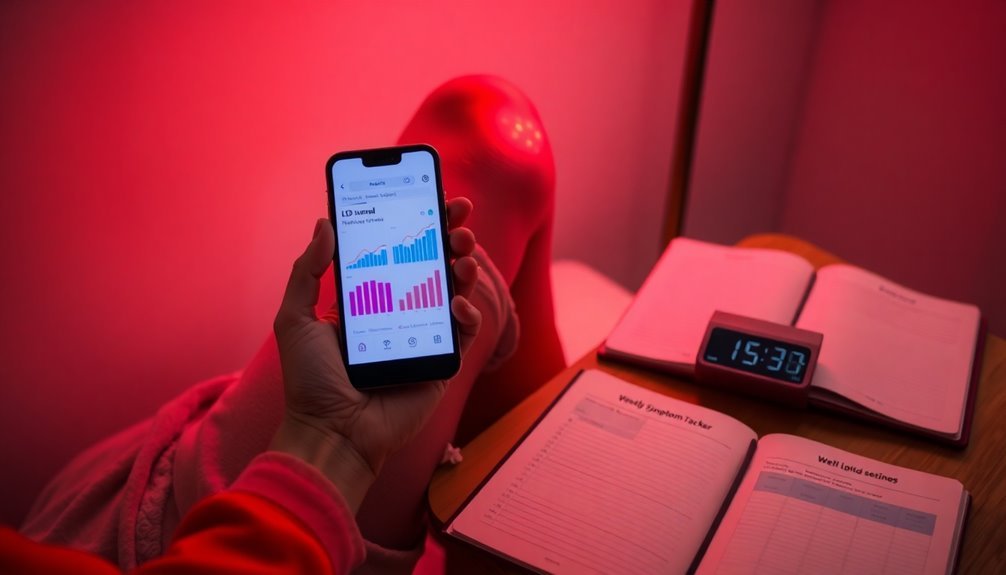
Throughout your light therapy journey, tracking progress systematically will help you determine the treatment's effectiveness for your joint pain. Begin by documenting your baseline pain levels, physical function, and any existing treatments you're using.
Regular assessments will provide valuable insights into your improvement over time.
Use standardized pain scales and objective measurements to monitor your progress. You'll want to track changes in joint function, inflammation levels, and overall mobility. If you notice any adverse effects, document them immediately and consult your healthcare provider about adjusting your treatment parameters.
- Record your pain levels before and after each session
- Measure joint circumference to track changes in swelling
- Keep a log of treatment frequency and duration
- Document any changes in your medication needs
- Track your daily activity levels and mobility improvements
Don't hesitate to modify your treatment plan based on your progress. If you're not seeing the expected results, consider exploring different wavelengths or combining light therapy with other treatments.
Work closely with your healthcare provider to review and adjust your treatment plan regularly, taking into account lifestyle factors that might affect your outcomes.
Frequently Asked Questions
Can I Use Red Light Therapy While Taking Anti-Inflammatory Medications?
Yes, you can safely use red light therapy while taking anti-inflammatory medications. There aren't any known interactions between them, and they may work together to enhance your pain relief and reduce inflammation.
How Soon After Joint Surgery Can I Start Red Light Therapy?
You can typically start red light therapy 24-48 hours after joint surgery, but you'll need your doctor's approval first. Each case is different, so follow your healthcare provider's specific timing recommendations.
Does Skin Color or Thickness Affect the Effectiveness of Red Light Therapy?
Your skin color and thickness do not substantially affect red light therapy's effectiveness. The light penetrates 5-10 millimeters deep into your tissue, and studies show equivalent benefits across all skin types and thicknesses.
Will Red Light Therapy Interfere With Medical Implants Near Joints?
You can safely use red light therapy with joint implants. It won't interfere with surgical implants and has even been used in joint replacement rehabilitation. Just follow manufacturer guidelines and consult your healthcare provider first.
Can Pregnant Women Safely Use Red Light Therapy for Joint Pain?
You can use red light therapy during pregnancy for joint pain, but consult your healthcare provider first. It's safe, non-invasive, and pain-free, but avoid direct abdominal exposure and keep sessions to 10-15 minutes.
In Summary
You'll get the most from light therapy for joint pain by following these seven essential tips. Remember to maintain consistency with your daily treatments, position devices correctly, and combine therapy with gentle movement. Track your progress to understand what works best for you. By selecting appropriate wavelengths and establishing an ideal treatment schedule, you're setting yourself up for successful pain management and improved joint health.

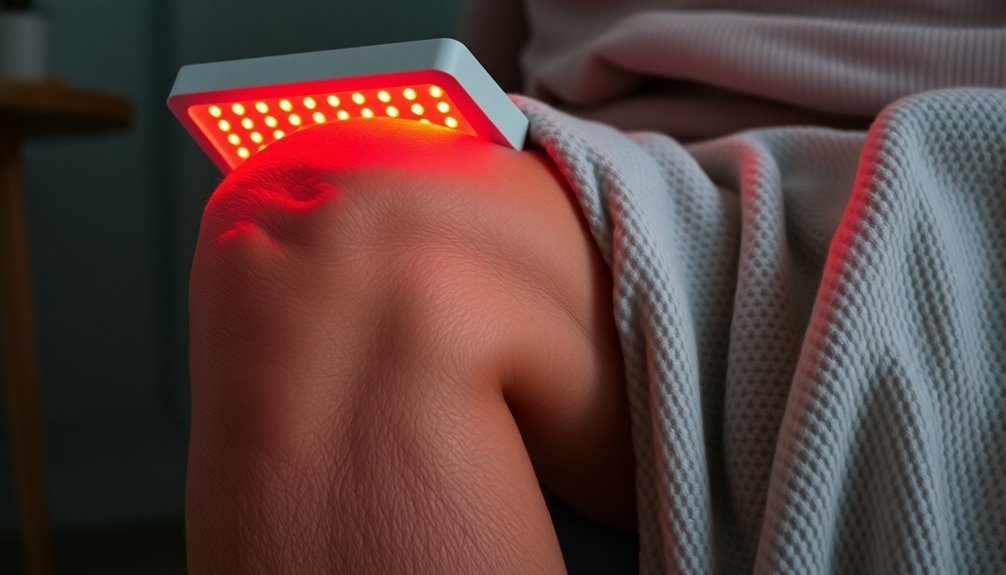



Leave a Reply